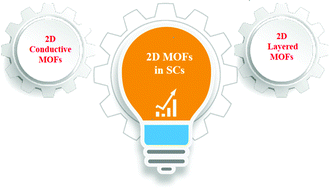Recent progress on pristine two-dimensional metal–organic frameworks as active components in supercapacitors
Abstract
Two-dimensional (2D) metal–organic frameworks (MOFs) are a new generation of 2D materials that can provide uniform active sites and unique open channels as well as excellent catalytic abilities, interesting magnetic properties, and reasonable electrical conductivities. Thus, these MOFs are uniquely qualified for use in applications in energy-related fields or portable devices because they possess fast charge and discharge ability, high power density, and ultralong cycle life factors. There has been worldwide research interest in 2D conducting MOFs, and numerous techniques and strategies have been developed to synthesize these MOFs and their derivatives. Thus, this is the opportune time to review recent research progress on the development of 2D MOFs as electrodes in supercapacitors. This review covers synthetic design strategies, electrochemical performances, and working mechanisms. We will divide these 2D MOFs into two types on the basis of their conductive aspects: 2D conductive MOFs and 2D layered MOFs (including pillar-layered MOFs and 2D nanosheets). The challenges and perspectives of 2D MOFs are also provided.

- This article is part of the themed collections: Dalton Transactions up-and-coming articles, 2021 Frontier and Perspective articles and Spotlight Collection: 2D Materials Chemistry


 Please wait while we load your content...
Please wait while we load your content...